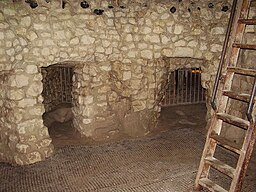Grimes Graves
| Grime's Graves | |
| Neolithic flint mine | |
|
Interior view of the public pit at Grime's Graves
|
|
| Country | England |
|---|---|
| Region | East of England |
| District | Breckland |
| Municipality | Brandon |
| Style | Neolithic |
| Founded | Around 3000 BC to 1900 BC, |
| Owner | Managed by English Heritage |
| Visitation | Located 7 miles NorthWest of Thetford off A134; postcode IP26 5DE. (1 to 31 March, 10am to 5pm, Saturday and Sunday only 1 April to 30 September, 10am to 6pm, every day 1 October to 31 October, 10am to 5pm, Except Tuesday and Wednesday) |
| Website: English Heritage | |
| Site also known as Grimes Graves. | |
Grime's Graves is a large Neolithic flint mining complex in Norfolk, England. It lies 8 km (5.0 mi) north east from Brandon, Suffolk in the East of England. It was worked between c. 3000 and c. 1900 BC, although production may have continued well into the Bronze and Iron Ages (and later) owing to the low cost of flint compared with metals. Flint was much in demand for making polished stone axes in the Neolithic period. Much later, when flint had been replaced by metal tools, flint nodules were in demand for other uses, such as for building and as strikers for muskets.
The scheduled monument extends over an area of some 37 ha (91 acres) and consists of at least 433 shafts dug into the natural chalk to reach seams of flint. The largest shafts are more than 14 m (46 ft) deep and 12 m (39 ft) in diameter at the surface. It has been calculated that more than 2,000 tonnes of chalk had to be removed from the larger shafts, taking 20 men around five months, before stone of sufficient quality was reached. An upper 'topstone' and middle 'wallstone' seam of flint was dug through on the way to the deeper third 'floorstone' seam which most interested the miners. The site is managed by English Heritage and can be visited.
In order to remove the chalk efficiently, the ancient miners built wooden platforms and ladders as they dug downwards and piled the spoil around the shaft opening using turf revetments to hold it in place for the season, when the shaft and all its galleries were thoroughly and fastidiously backfilled to promote stability. The landscape around Grime's Graves has a characteristic pockmarked appearance caused by the infilled shafts. This is probably what inspired the later Anglo-Saxon inhabitants of the area to name it after their god Grim (literally the masked, or hooded one, a euphemism for Woden). Although the pagan Anglo-Saxons seem to have had some idea of what the site was, as the name of the site means literally 'The masked one's quarries,' (or Grim's Graben,) it wasn't until Canon William Greenwell excavated one of the shafts from 1868- 1870 that their purpose was discovered in modern times. Other similar sites have been found in Europe like Cissbury in the United Kingdom, Krzemionki in Poland and Spiennes in Belgium.
...
Wikipedia

